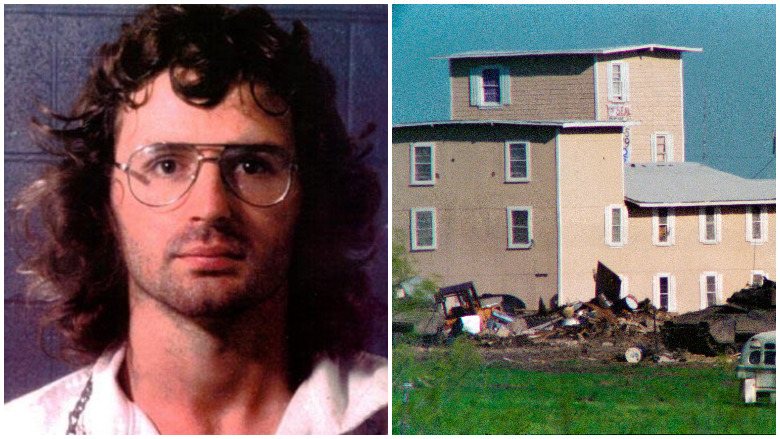
Mugshot/Getty The real David Koresh. Here's the true story behind the Branch Davidian tragedy in Waco.
Waco, the Netflix series that previously ran on Paramount Network, paints a narrative of extreme government misconduct in the fiery deaths of men, women, and children at the Branch Davidian compound in Texas.
However, is it all true? What’s the real story of Waco, Branch Davidian leader David Koresh, and the deadly blaze at Mount Carmel?
In the 1990s, U.S. House subcommittees conducted a year-long investigation into what happened. You can find that report’s findings here. We will contrast what happened in the show to the findings in the report and other accounts.
“From any perspective, Waco ranks among the most significant events in U.S. law enforcement history,” the report says. “For ATF, it was the largest and most deadly raid ever conducted. For the FBI, it was an unprecedented failure to achieve a critical objective–the rescue of dozens of innocent women and children.” In addition to Koresh, the series features a number of sub-characters who really did exist in real life, from some of Koresh’s wives to other men in the compound (for example, Koresh’s right-hand man Steve Schneider and his wife, Judy; talk show host Ron Engleman; David Thibodeau and his sham wife Michele Jones; negotiator Gary Noesner; and Davidian Wayne Martin were real people).
Seventy-six Branch Davidians lost their lives at Waco, including more than two dozen children. Four ATF agents also died.
Here’s what you need to know:
The Government Undercover Operation Near the Compound & Whether the Brand Davidians Had Illegal Firearms
The Netflix series shows federal agents taking over a home across from the Branch Davidian compound and one of them making it inside to converse with Koresh and others on several occasions. He then tries to warn the federal authorities that the Branch Davidians know they are coming and urges them to call off the raid. However, the ATF officials refuse and go ahead with what turns out to be a fatal and ill-fated standoff. The series also makes it appear that Koresh and the other Davidians don’t deal in illegal firearms.
What the report says: In June 1992, the Austin, Texas Office of the Bureau of Alcohol, Tobacco and Firearms (ATF) “opened a formal investigation into allegations” that Koresh and his followers “were in possession of illegal firearms and explosive devices.”
The report says that in January 1993, ATF agents did in fact commence “an undercover operation in a small house directly across from the property on which the Branch Davidians lived.” They posed as students in real life, and one agent met with Koresh several times “expressing an interest in their religious beliefs.” The ATF used evidence from this operation to receive an arrest warrant for Koresh and a warrant to search the compound from a federal judge.
The agent in question was named Jacob Vazquez in the show but was named Robert Rodriguez in real life.
The report found that the ATF’s investigation of the Branch Davidians “was grossly incompetent. It lacked the minimum professionalism expected of a major Federal law enforcement agency.”
For starters, although there was probable cause, the arrest and search warrant affidavits “contained an incredible number of false statements.”
According to the report, in May 1992, the Austin, Texas Office of the Bureau of Alcohol, Tobacco and Firearms was called by the sheriff, who said that the UPS had alerted his office that a package addressed to the compound had “broken open and contained firearms, inert grenade casings, and black powder.” Koresh’s offer to let authorities inspect the compound’s firearms was declined, which the report criticizes.
The New York Times reported in 1993 that an FBI expert testified that “48 fully automatic weapons were found in the charred ruins of the Branch Davidian compound.” Although most of the weapons were legal, not all of them were, according to this expert, who testified that “48 weapons had been illegally modified to be fully automatic.”
Allegations of Abuse
The series focuses on allegations against Koresh relating only to one of his “wives,” who was underage when he had a child with her. There’s conversation about Texas law allowing marriage to a 14 year old with parental consent, but not to two people at once (polygamy). And, without marriage, the sexual relations were illegal – a catch 22.
What the report says: The report says authorities “learned of numerous allegations that Koresh had had sexual relations with girls younger than 16 years of age.”
The report says:
It is clear that Koresh sexually abused minor females at the residence, in addition to having consensual sexual relations with several of the adult females who lived there. A number of former Davidians provided affidavits detailing these sexual relations, including the sexual abuse involving minors females. The report says there was no direct evidence that children were being abused during the time frame of the standoff itself.
The show doesn’t get into some of the more bizarre aspects of Koresh’s world. According to The New York Times, Koresh told the children they should call only him their father and refer to their parents as “dogs.” In addition, girls who were as young as 11 “were given a plastic Star of David,” which meant they could have sex with Koresh because they had “the light.” The children were disciplined with a paddle, and the compound had no running water or plumbing, The Times reported, adding that there was no formal schooling.
Who Shot First?
The series shows the federal authorities making the first move to provoke the shootout, killing dogs (gunfire then erupts) and shooting Koresh when he comes out in an attempt to make peace with his hands up.
What the report says: On February 28, 1993, “a force of 76 ATF agents stormed the Davidian residence to serve the arrest and search warrants.”
Who shot first? The report says:
Conflicting evidence on this point was presented to the subcommittees by the ATF agents who were involved in the raid, the Texas Rangers who conducted an investigation into the events of the raid following the end of the standoff on April 19, and by the attorneys for the Davidians.
One ATF agent testified that Koresh did come to the door “dressed in black cammo fatigues.”
As he closed the door, before we reached the door, one agent reached the door, and at that point that is when the doors erupted with gunfire coming from inside. It was 10 seconds or more before we even fired back.
The Texas Rangers, who conducted an investigation, concurred. Said one, Captain David Byrnes:
I believe the evidence was to me overwhelming in the trial that the Davidians fired first. The cameraman and the reporter, although very reluctantly, finally I believe conceded that. He had broadcast that several times. He was more or less a hostile witness. But in my mind there is no doubt who fired first.
In the show, there is just one cameraman whose videotape goes missing. The report does not describe the latter occurring.
The report says the Davidians’ attorneys believed the gun battle erupted because of “an accidental discharge by one of the ATF agents.”
The report concludes, “It appears more likely, however, that the Davidians fired first as the ATF agents began to enter the residence.”
The report says no evidence was found that anyone fired from the helicopter hovering overhead although the Davidians’ attorneys reported seeing bullet holes in the roof.
According to Frontline, who shot first is still disputed. “ATF agents who participated in the raid have testified in court and at a congressional hearing that the Branch Davidians fired the first shots,” the news site reports.
“Right after the raid, however, one ATF agent told an investigator that a fellow agent may have shot first, when he killed a dog outside the compound. The agent later retracted the statement, saying that the Branch Davidians had initiated the gunfire. Surviving Branch Davidians have maintained that they did not shoot their guns until they were fired upon by federal authorities.”
Were the Davidians Tipped Off in Advance?
The series shows the Davidians being tipped off by a postal worker who was asked by a cameraman for directions to the compound. Koresh laments that authorities could have just grabbed him when he was jogging or otherwise outside the compound.
What the report says: The Davidians did learn about the ATF’s raid in advance. The report says that the Davidians learned of the ATF plan to raid their residence “when a local television cameraman happened to get lost on his way to the Branch Davidian residence.” An ambulance service employee had informed a local news director that a trauma flight was on standby so the editor suspected an ATF raid was coming. The cameraman spoke to David Jones, “a Branch Davidian and a letter carrier with the U.S. Postal Service,” and mentioned a raid was coming, not knowing he was a Davidian. Jones then warned the Branch Davidians of the looming raid, the report says.
“As the agents arrived at the Davidians’ residence, the Davidians engaged the ATF agents in a gun battle which continued for almost 90 minutes,” the report says, indicating that the shootout left four ATF agents dead and more than 20 others wounded. In addition, the ATF killed two Davidians and wounded Koresh in this initial gun battle.
The report lays the blame at Koresh’s feet in part:
But for the criminal conduct and aberrational behavior of David Koresh and other Branch Davidians, the tragedies that occurred in Waco would not have occurred. The ultimate responsibility for the deaths of the Davidians and the four Federal law enforcement agents lies with Koresh.
But the report calls the raid plan significantly flawed:
The plan was poorly conceived, utilized a high risk tactical approach when other tactics could have been successfully used, was drafted and commanded by ATF agents who were less qualified than other available agents, and used agents who were not sufficiently trained for the operation. Additionally, ATF commanders did not take precautions to ensure that the plan would not be discovered.
It finds fault with the ATF tactics, saying the agency “exercised extremely poor judgment” and could have just arrested Koresh outside the compound. The report concludes:
The senior ATF raid commanders, Phillip Chojnacki and Chuck Sarabyn, either knew or should have known that the Davidians had become aware of the impending raid and were likely to resist with deadly force. Nevertheless, they recklessly proceeded with the raid, thereby endangering the lives of the ATF agents under their command and the lives of those residing in the compound. This, more than any other factor, led to the deaths of the four ATF agents killed on February 28.
“ATF agents misrepresented to Defense Department officials that the Branch Davidians were involved in illegal drug manufacturing,” the report says.
Negotiations With the Davidians & Negotiator Gary Noesner
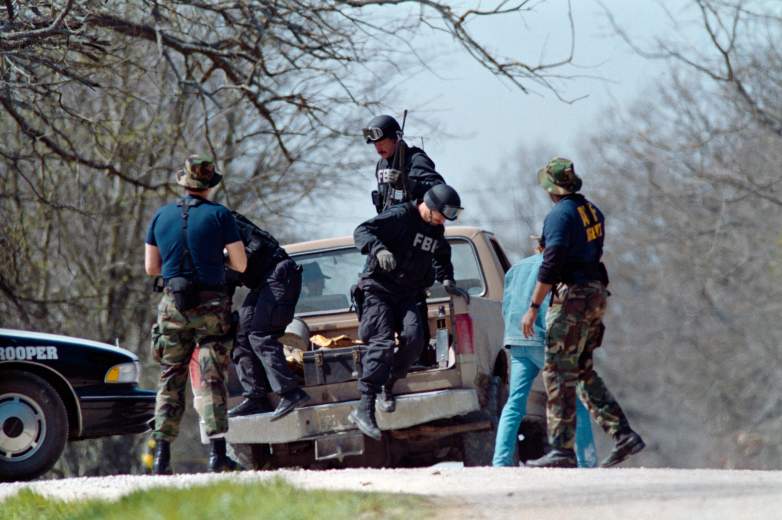
FBI agents unload from a pickup truck on March 12, 1993 near the Branch Davidian religious compound. After a shootout in Waco in 1993 that killed four federal agents and six members of the Branch Davidian religious sect, authorities negotiated with cult leader David Koresh for 51 days. On the final day, 19 April 1993, a few hours after a government tank rammed the cult’s wooden fortress, the siege ended in a fiery blaze, killing Koresh and 80 of his followers.
The series focuses a lot of screen time on the negotiator for the FBI who tries to talk Koresh into surrendering and slowly secures the release of dozens of children. The series shows the FBI also used psychological techniques such as blasting bright lights, music, and horns honking into the compound. The series also shows Koresh promising to surrender after finishing a religious manuscript, but then the FBI moving ahead before he completed it. The show focuses a lot of time on lead FBI negotiator Gary Noesner. It was based in part on the real Noesner’s book, Stalling for Time: My Life as an FBI Hostage Negotiator.
In real life, Noesner was involved in the standoff for 25 days as a negotiator and he was pulled off because he wasn’t seen as being aggressive enough, according to Men’s Health.
What the report says: It’s true that the FBI sent members of its Hostage Rescue Team to Waco and took charge of the situation. The standoff lasted 51 days, and there were “daily negotiations” between the FBI and the Davidians.
Eventually, 35 people, including 21 children, did leave the compound and surrender. According to the report, “tactics included…cutting off electricity to the residence, and at one point, shining bright lights at the residence and playing loud music and irritating sounds over loudspeakers.”
The report does say that officials in real life closed their minds to continued negotiation “when presented with evidence of a possible negotiated end following completion of Koresh’s work on interpreting the Seven Seals of the Bible.” It’s true that Koresh maintained he was working on a manuscript and would then surrender, the report says, but FBI officials thought it was just a stall tactic.
Noesner wasn’t really at Ruby Ridge, according to The Smithsonian, which quoted him as saying that, as a negotiator, he expected that Koresh wouldn’t live up to every promise. But “at Waco, our on-scene commander and the tactical commander took those behaviors in a very negative way,” he said. “Then they would take actions that would the only ratchet up things with David. So it was a very complex tragedy.”
The Use of Gas & the Role of Attorney General Janet Reno

US Attorney General Janet Reno (R) speaks to Assistant US Attorney Steven Zippenstein (L) before testifying to a congressional subcommittee in Washington on the final day of two weeks of hearings into the loss of over 80 lives in the 1993 raid on the Branch Davidian compound near Waco, Texas. Reno, in her prepared testimony, insisted that cult leader David Koresh was solely responsible for the deaths of his followers.
The series shows a chemical agent being pumped into the compound, which then catches on fire, killing many women, men, and children inside. It also shows the Attorney General, Janet Reno, giving the green light for the operation.
What the report says: During the week of April 12, Reno, senior Justice Department officials, and FBI officials met about a plan to end the standoff. “The proposed plan centered around the use of a chemical riot control agent which would be injected through the walls of the Davidian residence in order to induce the residents to leave the structure,” the report says. “It provided for the methodical insertion of the riot control agent into different parts of the building over a 48 hour period.” Reno approved the plan for April 19, 1993.
The report describes how it unfolded.
At approximately 6 a.m. on April 19, the FBI’s chief negotiator, Byron Sage, telephoned the Davidians and informed them that the FBI was inserting the riot control agent into the residence. Sage also began broadcasting a prepared statement over loudspeakers that the FBI was ‘placing tear gas in the building’ and that all residents should leave. As the announcement was being made, FBI agents using unarmed military vehicles with booms mounted on them began to insert the riot control agent into the compound by ramming holes into the sides of the structure and then using devices mounted on the booms to spray the riot control agent into the holes in the walls. Almost immediately the Davidians began to fire on the vehicles being used by the FBI. At 6:07 a.m., the commander of the Hostage Rescue Team ordered that the contingency provision of the operations plan be implemented and that the riot control agent be inserted in all portions of the residence at once. During 6 hours of insertion of the riot control agent no residents exited the compound.
The series doesn’t show the Davidians firing on the authorities at this point.
The report contains harsh criticism for Reno.
The decision by Attorney General Janet Reno to approve the FBI’s plan to end the standoff on April 19 was premature, wrong, and highly irresponsible. In authorizing the assault to proceed Attorney General Reno was seriously negligent. The Attorney General knew or should have known that the plan to end the stand-off would endanger the lives of the Davidians inside the residence, including the children.
It concludes that the FBI “failed to demonstrate sufficient concern for the presence of young children, pregnant women, the elderly, and those with respiratory conditions” and that the injection of gas into the compound “could have been a proximate cause of or directly resulted in some or all of the deaths attributed to asphyxiation in the autopsy reports.”
According to The Washington Post, a surveillance videotape shows an assistant special agent “can be heard authorizing the use of a military tear gas cartridge in an attempt to penetrate the entrance to an underground storm shelter that was about 50 yards from the main compound structure.”
The Fire & Deaths Inside, Including the Cause of Death of David Koresh
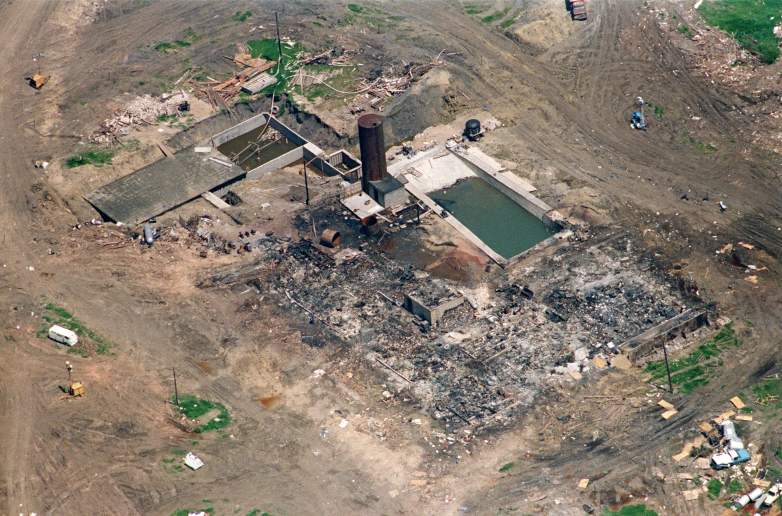
This aerial shot taken 21 April 1993 in Waco from the government mandated 5000 feet shows the burnt remains of the only structure left standing after a fire destroyed the The Branch Davidian cult compound 19 April. FBI and Texas Rangers continue the area for victims of the blaze which ended a 51 day standoff between federal agents and the cult lead by David Koresh.
The series shows the fire ignite in the compound after gas is injected into it by the government, and it shows Steve Schneider, Koresh’s right-hand man, take Koresh’s life before killing himself. The series implies that the other people who died inside the compound died from the blaze or gas. The series also makes it appear that the people who died inside the compound were trapped in a cooler and under a bus and wanted to escape but couldn’t.
What the report says: The report says that the fire broke out at 12:07 p.m., and then within two minutes, two other fires developed. It took only eight minutes before three fires “engulfed the entire structure.”
The report says “the largest group of bodies recovered after the fire was found in the area of the residence commonly known as the gun room or bunker.” If the gas went directly into the bunker, which was not clear, it didn’t cause the deaths of those inside it, the report says.
According to the report, sounds of gunfire broke out, and some of them were “methodical and evenly-spaced, indicating the deliberate firing of weapons.” Nine people escaped, and 19 of those who perished “died from gunshots at close range,” the report says, adding that the rest died of smoke inhalation or the fire.
The report says those gunshots were “either self-inflicted, inflicted by other Davidians, or the result of the remote possibility of accidental discharge from rounds exploding in the fire.”
The series only shows Schneider and Koresh dying from gunshots, with Schneider killing Koresh and then committing suicide. According to the New York Times, in real life, Koresh was found dead of a bullet wound “in the center of his forehead,” but authorities didn’t say whether he was killed or committed suicide. They couldn’t determine that for sure because his body was burned so badly. (You can read more about Koresh’s cause of death here.)

Autopsy reportA diagram in the David Koresh autopsy report.
The report says that there is no evidence that FBI agents fired their guns in that instance.
The report accuses the Davidians of setting the fires. “Some of the Davidians intentionally set the fires inside the Davidian residence,” it says. “There is no evidence that the FBI intentionally or inadvertently set the fires on April 19.” The report explains:
The experts testified that they believed the fires were intentionally set by Branch Davidian members in order to destroy the structure. Supporting this conclusion is that fact that the fire review team found that a number of accelerants were present in the structure and on the clothing of some of the surviving Davidians, including gasoline, kerosene, Coleman fuel, and other accelerants…Because no fireball was observed until well after the fire had become established, the subcommittees conclude that methylene chloride did not cause the fire.
However, one committee member disagreed, writing, “I believe there is also the possibility that the fire, or at least some of the fires, may have been caused as a result of the demolishing efforts of the armored military vehicles.”
In addition, in a break from the show, the report says the Davidians “could have escaped the residence for a significant period of time after the start of the fire.” Most of the Davidians “either did not attempt to escape from the residence or were prevented from escaping by other Davidians.”
As for government accountability, the report says that Treasury Department officials “failed to properly supervise ATF activities leading to the raid.” The report also indicates that “the Department terminated the employment of the two senior raid commanders, (Phillip) Chojnacki and (Charles) Sarabyn.” They were both rehired by the ATF but not in supervisory capacity, the former of which the report criticizes.
According to Frontline, some surviving Branch Davidians “insist that they did not start the fire,” but a panel of arson investigators disagreed.
They believed that “unless they were deliberately set, the probability of the three fires starting almost simultaneously was highly unlikely,” and FBI listening devices captured Davidians saying things like “spread the fuel” six hours before the blaze. “Furthermore, the videotapes show the use of accelerants that strongly increased the spread of the fire,” reports Frontline, which added that it did not appear to be a “mass suicide.”
According to Frontline, the feds really did bug milk cartons and they obtained audio of conversations that led them to believe the Davidians set the fires. A portion of that:
1st DAVIDIAN: [surveillance tape] Start the fire?
2nd DAVIDIAN: Got some fuel around here?
3rd DAVIDIAN: Right here.
Read the rest here.
David Thibodeau & Michele Jones
David Thibodeau was a real person. In the show, Koresh is shown enticing him to live at the compound after asking him to drum a set with his band. Thibodeau is then asked to marry one of Koresh’s “wives,” to protect the Branch Davidian leader from claims he had sexual relations (and a child) with the woman when she was underage.
What the report says: Thibodeau “lived at the Branch Davidian residence but did not consider himself to be a member of the Branch Davidian religious community,” the report says. It indicates that he did testify before Congress, as is shown in the series.

Branch Davidian David Thibodeau of ‘Waco’ speaks onstage during the Paramount Network portion of the 2018 Winter TCA on January 15, 2018 in Pasadena, California.
According to the Dallas Observer, the real Thibodeau did meet Koresh while playing music with him. He did move into the compound, and he did escape from it. The Netflix series was based in part on his book, Waco: A Survivor’s Story. In 2018, he was living in Maine. It’s true that he was one of only nine people to escape the blaze.
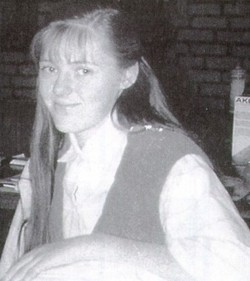
The real Michele Jones.
“I just want the people inside to be humanized,” said Thibodeau, according to the Smithsonian. “They died for what they believed in, whether you believe that or not. To me, they’re martyrs, and they shouldn’t just be demonized and hated.”
The Smithsonian reports that Thibodeau met Koresh in real life at a guitar center. Thibodeau doesn’t believe the Branch Davidians started the fire, according to that site.
In 1999, the Austin Chronicle described Thibodeau as “an endearing, slightly goofy man of average size with sharp blue eyes and floppy brown hair.” He was living in Austin, Texas, then, and was working “as an account executive for a direct marketing firm that caters to high-tech companies.”

Branch Davidian cult members Jaime Castillo (L) and David Thibodeau (C) are led from the federal court building after their arraignment 20 April 1993 in Waco, TX. The men were two of only nine members of the cult to survive the blaze that destroyed the Branch Davidian compound 19 April.
What of the sham marriage to Koresh’s “wife” Michele? Is that true?
In his book he wrote, “By April 1993, David had had sexual relations with a total of 15 women — and had fathered 17 children with 11 of them.”
Indeed, wrote Thibodeau, Koresh had sexual relations with Michele Jones, who was the sister of his first wife Rachel, and claimed he did so as the result of a vision. Rachel agreed when she had a dream about it.
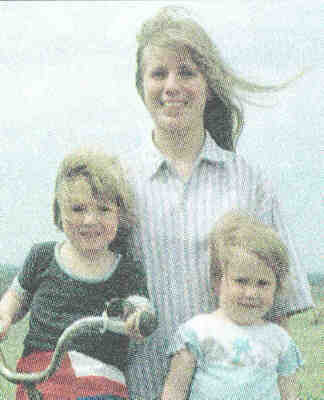
Rachel Jones Koresh
Michele was 12 years old at the time and had Koresh’s child Serenity two years later. Altogether, though, the real Michele had three children by Koresh. Koresh did ask Thibodeau to marry Michele, which he did without ceremony. Even though the marriage was in name only, it meant something to Thibodeau, who said, according to the Austin Chronicle, “Somehow, being a husband, even in name only, settled me.”
Michele and her children did die in the fire, as did Rachel.
Steve & Judy Schneider
Steve Schneider is presented in the show as Koresh’s right-hand man who kills him in the end before killing himself. He is married to wife Judy, but he allows Koresh to take her as his own wife and father a child with Judy.
According to the Waco Tribune, the real Steve was Koresh’s “chief lieutenant, who often negotiated with authorities during the standoff,” and his wife, Judy, was legally married to Schneider but was one of Koresh’s “wives.”
A 1993 article by Cox News Service described the couple’s saga, saying that, when they married, they were “the all-American dream couple.” Steve said Judy’s daughter Mayanah was his, but Koresh told people the baby was his. It was also true that the men of the compound had to remain celibate – except for Koresh.
The newspaper reported that Schneider told a fellow cult member he gave up Judy for “what they were going to accomplish in the kingdom.” Both were from Wisconsin. He graduated from the University of Hawaii with a degree in religion.
READ NEXT: David Koresh’s Wife Rachel.
Comments
Waco on Netflix: What’s the Real Story of the Tragedy?